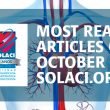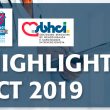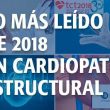1- Incidence and Prognosis of Heart Valve Embolization The incidence of peri-procedural transcatheter heart valve embolization and migration (TVEM) is as low as 1%. However, it is associated with increased morbidity and mortality. Read more HERE 2- 1000 MitraClips: Results from the World’s Most Experienced Site In September 2008, interventional physicians at the Heart and<a href="https://solaci.org/en/2019/11/07/the-most-read-scientific-articles-of-october-in-interventional-cardiology/" title="Read more" >...</a>
TCT 2019 | EXCEL: Left Main Coronary Artery Angioplasty with Favorable Results at 5 Years
Courtesy of Dr. Carlos Fava. Unprotected left main coronary artery angioplasty with drug-eluting stents has emerged as an acceptable strategy for a select group of patients, with results comparable to those of myocardial revascularization surgery at 2 or 3 years. However, beyond such term, we had no valid information. Researchers analyzed the 5-year follow-up results for the<a href="https://solaci.org/en/2019/10/01/tct-2019-excel-left-main-coronary-artery-angioplasty-with-favorable-results-at-5-years/" title="Read more" >...</a>
TCT 2019 | EVOLVE Short DAPT: Only 3-month DATP in High Risk Bleeding
Courtesy of the SBHCI. This study used the thin strut everolimus eluting stent with ultrathin abluminal bioresorbable polymer coating chromium platinum stent, basically the Synergy stent. Drug release and polymer degradation within four months facilitate endothelization and would allow a shorter DAPT. Presented during the scientific sessions of TCT 2019, this study included 2009 high<a href="https://solaci.org/en/2019/09/30/tct-2019-evolve-short-dapt-only-3-month-datp-in-high-risk-bleeding/" title="Read more" >...</a>
ACC 2019 | AUGUSTUS: Apixaban Plus P2Y12 Inhibitor Is the Best Combination in Atrial Fibrillation and Angioplasty
Aspirin increases bleeding with no ischemic benefit, but a trend toward more stent thrombosis with placebo warrants further studies. Patients with atrial fibrillation who receive an anticoagulant agent and coronary angioplasty with a stent, and then continue with aspirin, experience an increased risk of bleeding without any ischemic benefit whatsoever. The use of a<a href="https://solaci.org/en/2019/03/25/acc-2019-augustus-apixaban-plus-p2y12-inhibitor-is-the-best-combination-in-atrial-fibrillation-and-angioplasty/" title="Read more" >...</a>
The Most Important Articles of 2018 in Structural Heart Diseases
1- ESC 2018 | MITRA FR: Testing MitraClip for Secondary Mitral Regurgitation In secondary mitral regurgitation, mitral-valve leaflets and chordae are structurally normal and mitral regurgitation results from alterations in left ventricular geometry and function. Read more 2- TCT 2018 | COAPT: MitraClip in Patients with Secondary Mitral Regurgitation The prognosis of patients with<a href="https://solaci.org/en/2019/01/18/the-most-important-articles-of-2018-in-structural-heart-diseases/" title="Read more" >...</a>
Safety of Combining New Anticoagulant Agents and Dual Antiplatelet Therapy
Atrial fibrillation is the most common arrhythmia and its combination with a history of acute myocardial infarction or coronary angioplasty is quite frequent. According to this study (recently published in JACC), in a real-world population, the combination of direct anticoagulant agents and dual antiplatelet therapy reduces significantly the risk of bleeding and provides similar thromboembolic<a href="https://solaci.org/en/2018/11/20/safety-of-combining-new-anticoagulant-agents-and-dual-antiplatelet-therapy/" title="Read more" >...</a>
New Anticoagulant Agents in Atrial Fibrillation in Latin American Patients, Specifically
There is limited information on the use of antithrombotic therapies and their outcomes in Latin American patients with atrial fibrillation. This stands true in almost all aspects of medicine: large multicenter randomized studies rarely include Latin American countries, and when they do, the population included is not representative of the overall population. The only exception<a href="https://solaci.org/en/2018/11/02/new-anticoagulant-agents-in-atrial-fibrillation-in-latin-american-patients-specifically/" title="Read more" >...</a>
TCT 2018 | OAC-ALONE: Anticoagulation Alone 1 Year After Stenting in Patients with Atrial Fibrillation
Up to now, there had been no randomized controlled trial assessing oral anticoagulation alone vs. oral anticoagulation plus antiplatelet therapy in patients with atrial fibrillation 1 year after stenting in a setting of stable coronary disease. Such was the vacuum that this work, presented at TCT 2018 and published simultaneously in Circulation, attempted to fill. This trial<a href="https://solaci.org/en/2018/10/08/tct-2018-oac-alone-anticoagulation-alone-1-year-after-stenting-in-patients-with-atrial-fibrillation/" title="Read more" >...</a>
NSAIDs and Risk of Bleeding in Patients with Atrial Fibrillation
The use of nonsteroidal anti-inflammatory drugs (NSAIDs) is very frequent and many of these medications are sold over-the-counter, but they can expose patients with atrial fibrillation using warfarin or dabigatran to potentially dangerous bleeding. Such a combination is a “perfect storm” of sorts, since atrial fibrillation is the most frequent type of arrhythmia and its<a href="https://solaci.org/en/2018/07/24/nsaids-and-risk-of-bleeding-in-patients-with-atrial-fibrillation/" title="Read more" >...</a>
Five-Year Outcomes for Appendage Closure
The PROTECT AF (WATCHMAN Left Atrial Appendage System for Embolic Protection in Patients With Atrial Fibrillation) trial demonstrated that left atrial appendage closure with the Watchman device was equivalent to warfarin for preventing stroke in atrial fibrillation, but it had a high rate of peri-procedural complications. The follow-up randomized trial was PREVAIL (Evaluation of the<a href="https://solaci.org/en/2018/02/09/five-year-outcomes-for-appendage-closure/" title="Read more" >...</a>








